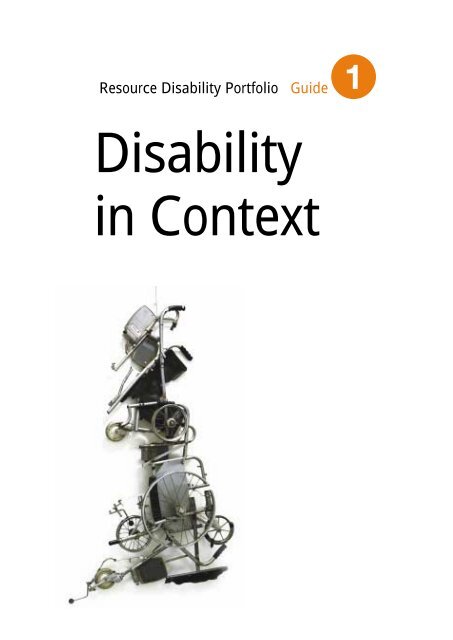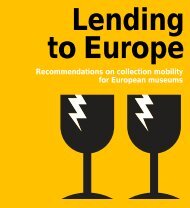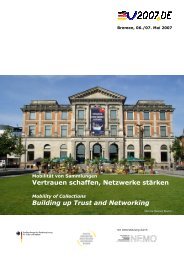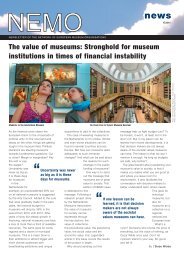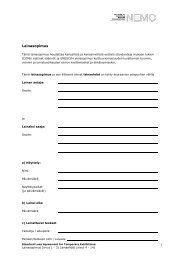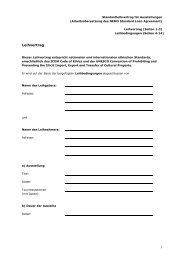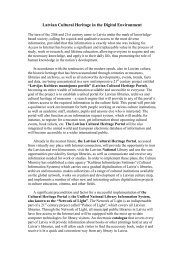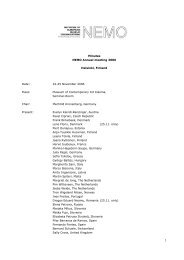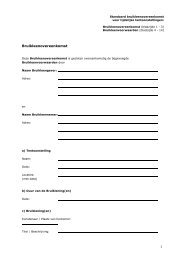Resource Disability Portfolio Guide 1 - Network of European ...
Resource Disability Portfolio Guide 1 - Network of European ...
Resource Disability Portfolio Guide 1 - Network of European ...
Create successful ePaper yourself
Turn your PDF publications into a flip-book with our unique Google optimized e-Paper software.
<strong>Resource</strong> <strong>Disability</strong> <strong>Portfolio</strong> <strong>Guide</strong>1<br />
<strong>Disability</strong><br />
in Context
Use <strong>Guide</strong> 1 to gain understanding about how disabled people<br />
place themselves within society and to learn what factors<br />
influence their choice <strong>of</strong> services.<br />
Author: Annie Delin<br />
The <strong>Portfolio</strong> is published as a result <strong>of</strong> collaboration with a working<br />
party, which includes specialist consultants, and aims to support<br />
the elimination <strong>of</strong> discrimination in service provision. The views<br />
expressed in these guides are not necessarily those <strong>of</strong> <strong>Resource</strong>.<br />
© <strong>Resource</strong> 2003<br />
Registered Charity No. 1079666<br />
ISBN 1-903743-14-1<br />
Designed by Satpaul Bhamra<br />
A CIP catalogue record <strong>of</strong> this publication is available<br />
from the British Library.<br />
Front cover:<br />
A disabled artist’s view: Great Britain from a Wheelchair,<br />
Tony Heaton, 1995.
Contents<br />
Introduction<br />
6<br />
1<br />
Who disabled people are<br />
Characterising disability<br />
8<br />
2<br />
Rights for disabled people<br />
Your duties under the law<br />
Changing legislation<br />
The idea <strong>of</strong> ‘community’<br />
11<br />
3<br />
How disabled people view themselves<br />
Politics and rights<br />
Companionship and support<br />
Deaf culture<br />
British Sign Language<br />
Social/medical models<br />
Defining disability<br />
Self-definition as a choice<br />
15<br />
4<br />
Everyday experiences<br />
Institutional culture<br />
Physical access<br />
Representation<br />
Education<br />
Gaining information<br />
22<br />
Conclusion<br />
24<br />
Further information<br />
Publications<br />
25
Over a long period, up to recent times,<br />
the accepted way to view disability<br />
was as a state deserving <strong>of</strong> benevolence<br />
and pity. The new view <strong>of</strong> disabled<br />
people is as valuable citizens with<br />
equal rights, who make their own life<br />
decisions and choices.<br />
Early 20th Century stained glass,<br />
National Library for the Blind. © NLB<br />
4
Introduction<br />
The identity <strong>of</strong> disabled people has undergone dramatic change<br />
over recent decades. How they view themselves affects how they<br />
behave, and how you view them affects how you serve them.<br />
Over a long period, up to recent times, the accepted way to view<br />
disability was as a state deserving <strong>of</strong> benevolence and pity. In this<br />
context, it was not common to provide equal access to services or<br />
to <strong>of</strong>fer real choice to disabled users. The deserving receiver was<br />
expected to be grateful, pleased and apologetic, and had no choice<br />
unless their physical, intellectual or sensory needs were minor.<br />
Change began in 1981, when the International Year <strong>of</strong> Disabled<br />
People focused attention on the topic and made some disabled<br />
people more aware <strong>of</strong> their own numbers. The doctrine <strong>of</strong> equal<br />
opportunities focused on an obligation not to discriminate, because<br />
it wasn’t fair. This approach was harder in relation to disabled<br />
people, since to meet their needs was seen as expensive and<br />
difficult by comparison to a non-discriminatory attitude towards<br />
other groups. Equal opportunities for disabled people were viewed<br />
as a drain on resources, resulting in disabled people being less<br />
equal than others.<br />
In the years leading up to 1995, the notion <strong>of</strong> disability rights<br />
developed. This idea took strength from what was happening in<br />
America and elsewhere, and defined disabled people as people<br />
with something to contribute, who had the right to both give to and<br />
take from society. This idea was the foundation for a high pr<strong>of</strong>ile<br />
disability movement and was an influential force for change, leading<br />
to the implementation <strong>of</strong> the <strong>Disability</strong> Discrimination Act (DDA)<br />
1995, and later to the creation <strong>of</strong> the <strong>Disability</strong> Rights Commission<br />
(DRC), to enforce the Act.<br />
6
Today, society is subject to many cultural influences. Each <strong>of</strong> the<br />
three attitudes described above is still present, both among service<br />
providers and disabled people themselves. Change is slow, but it<br />
doesn’t go backwards. The new view <strong>of</strong> disabled people as valuable<br />
citizens with equal rights, who make their own life decisions and<br />
choices, continues to gain ground and shows disabled people as<br />
part <strong>of</strong> society and influential on its progress.<br />
Disabled people can contribute on all levels – by saying what they<br />
want from services, working for organisations, suggesting change,<br />
passing on recommendations, swelling visitor numbers. The culture<br />
<strong>of</strong> social inclusion recognises that disabled people exist, meets their<br />
needs and creates a space where they can contribute.<br />
7
1<br />
Who disabled people are<br />
As a starting point, many people ask “How many are there?”<br />
Statistics are risky, because they can be made to say almost<br />
anything. It is, however, fair to say that disability is present in<br />
more ways, and in different proportions, than many people realise.<br />
<strong>Disability</strong> is more prevalent than most people believe because so<br />
many circumstances and conditions can lead to a temporary or<br />
permanent state <strong>of</strong> disability. It is hard to ask the right question to<br />
get a definition, because people are influenced by factors such as<br />
embarrassment, pride and political opinion when they identify as<br />
disabled. (See p.21 about self-definition).<br />
Based on questions asked in the census, there are currently<br />
estimated to be 8.6 million disabled people in Britain (15 per cent).<br />
This includes over 6.8 million <strong>of</strong> working age (Labour Force Survey<br />
spring 2002).<br />
Of disabled people, around 5 per cent use a wheelchair (in other<br />
words, 95 per cent do not). Of the 5 per cent, many do not use<br />
a wheelchair ‘full-time’ but only for occasional or long-distance use.<br />
The erroneous perception that a wheelchair user is the only<br />
‘real’ disabled person has been reinforced by the adoption <strong>of</strong> the<br />
wheelchair badge as a symbol for disability.<br />
The total UK adult population with any hearing impairment is<br />
8.6 million (15 per cent) according to the Royal National<br />
Institute for Deaf People (RNID). This includes approximately<br />
50,000–70,000 British Sign Language users.<br />
8<br />
According to the Royal National Institute for the Blind (RNIB) and<br />
Office for Population Censuses and Surveys (OPCS), there are<br />
1.7 million people with a visual impairment. Over 90 per cent have<br />
some sight.
According to Deafblind UK, 23,000 people are deafblind but many<br />
more people, especially if they are over 65, have some degree <strong>of</strong><br />
both sight and hearing loss.<br />
The number <strong>of</strong> adults and children in the UK with learning<br />
disabilities is estimated at 1.2 million (2 per cent) according to<br />
Mencap.<br />
People experiencing mental health issues at any one time total one<br />
in seven (14 per cent) according to Mind. This is based on figures<br />
from the OPCS, and from the Audit Commission.<br />
Help the Aged gives the figure <strong>of</strong> 9 million people over the age<br />
<strong>of</strong> 65, or 15.7 per cent <strong>of</strong> the population. This influences the<br />
perception <strong>of</strong> disability statistics, because <strong>of</strong> the strong relationship<br />
between age and actual disability. 34 per cent <strong>of</strong> those aged<br />
50 plus have a disability, compared with 10 per cent among<br />
16–24 year-olds.<br />
None <strong>of</strong> the above are necessarily mutually exclusive and many<br />
people have more than one impairment.<br />
Characterising disability<br />
It is important to look at what characterises the experience <strong>of</strong> being<br />
disabled, because this can create the conditions which categorise<br />
people socially and economically. <strong>Disability</strong> can arise for all kinds<br />
<strong>of</strong> reasons, and can lead to deprivation in various ways.<br />
Disabled people are twice as likely as others to have no<br />
qualifications – education is not as consistently available, and is<br />
<strong>of</strong>ten at a lower academic standard than for others, while further<br />
and higher education, vocational training and work experience<br />
9
can all be harder to access (Labour Force Survey spring 2002).<br />
Employment is an area <strong>of</strong> huge disadvantage. Disabled people are<br />
around five times as likely as non-disabled people to be out <strong>of</strong> work.<br />
People who become disabled while they are working have a one<br />
in six chance <strong>of</strong> losing their job while one third <strong>of</strong> all disabled people<br />
who find work are out <strong>of</strong> a job within a year (Labour Force Survey<br />
spring 2002).<br />
Losing the opportunity to work, and being disadvantaged in<br />
job-seeking, can lead to low income and benefit dependency.<br />
Having said this, many disabled people find ways to fit their working<br />
lives around disability and, when adequately supported, generate<br />
income for themselves and economic benefit to society.<br />
Disabled people exist in all roles, and their family or social position<br />
is a powerful argument in the business case for providing better<br />
services. A disabled parent, child, friend or partner may influence<br />
the choices non-disabled people make. The spending power <strong>of</strong><br />
disabled people in the UK is estimated at £45–50 billion.<br />
10
2<br />
Rights for disabled people<br />
Disabled people have long been campaigning for comprehensive<br />
and enforceable civil rights, arguing that previous legislation<br />
had failed to deliver as intended. The 1944 Disabled Persons<br />
(Employment) Act aimed to ensure that employers employed<br />
a certain number <strong>of</strong> disabled people. It asked disabled people to<br />
register to demonstrate eligibility for employment.<br />
However, although many disabled people registered, few employers<br />
were prosecuted for failing to meet their obligations. The system<br />
became unenforceable, the concept ‘registered disabled’ being<br />
all that remained <strong>of</strong> the idea. Registration ceased in 1995 when<br />
the <strong>Disability</strong> Discrimination Act (DDA) came into force, and should<br />
no longer be used as a pro<strong>of</strong> <strong>of</strong> eligibility for concessions.<br />
One other legacy from this legislation was the conviction among<br />
campaigners that legislation without enforcement would be<br />
toothless. This formed part <strong>of</strong> the case leading to the establishment<br />
<strong>of</strong> the <strong>Disability</strong> Rights Commission (DRC) (see below).<br />
The DDA was enacted in 1995, with an implementation programme<br />
which extends to 2004. For the first time in UK legislation, it<br />
introduces measures aimed at ending discrimination. It establishes<br />
the right <strong>of</strong> access to goods, services and facilities and puts an<br />
anticipatory duty on service providers to know the needs <strong>of</strong> disabled<br />
people and how they can be met.<br />
The DDA does not provide full civil rights, but it was significantly<br />
strengthened by the creation <strong>of</strong> the DRC – with similar enforcement<br />
powers to those <strong>of</strong> other commissions. The DRC also plays<br />
an advisory role and has the power to initiate enquiries into the<br />
DDA’s implementation.<br />
11
Some disabled individuals have embraced the idea that they have<br />
rights, but are not well-informed about how far these rights extend,<br />
or in what situations they are applicable. One reason for informing<br />
yourself about the DDA is to be able to judge when you are asked<br />
to do something which the law does not require.<br />
Your duties under the law<br />
The <strong>Disability</strong> Discrimination Act (DDA) covers the areas <strong>of</strong><br />
employment, access to goods, facilities and services and the<br />
management <strong>of</strong> land and property.<br />
Since December 1996 it has been unlawful for employers to treat<br />
disabled people less favourably than other people for a reason<br />
related to their disability. Employers have had to make reasonable<br />
adjustments so that disabled people are not disadvantaged.<br />
Since October 1999 it has become unlawful for service providers<br />
to refuse to serve someone for a reason related to disability, to <strong>of</strong>fer<br />
a service on different terms, or to provide a service <strong>of</strong> a lower<br />
standard. Service providers have to make reasonable adjustments<br />
so that disabled people can access their services. They have to<br />
review policies, practices and procedures and, where a physical<br />
barrier exists, they have to provide a reasonable alternative to make<br />
service available.<br />
From 2004 service providers will have to make changes to physical<br />
features so that disabled people can use their services. (For more<br />
information on the DDA see <strong>Guide</strong> 5.)<br />
12
Changing legislation<br />
Within the disability movement, overseas examples are seen as<br />
indicators <strong>of</strong> the changes to come in Britain. The momentum for<br />
civil rights <strong>of</strong> disabled people in the UK was in part inspired by<br />
disability legislation in the US (Americans with Disabilities Act).<br />
The US developed this legislation in the aftermath <strong>of</strong> the Vietnam<br />
war, to support the social inclusion <strong>of</strong> veterans. Australia also<br />
now has the Australians with Disabilities Act and, in a groundbreaking<br />
case, their courts found the Olympic Games <strong>of</strong> Sydney<br />
guilty <strong>of</strong> denying blind people access to its website.<br />
<strong>European</strong> policy will have impact on the development <strong>of</strong> disability<br />
rights in the UK. The <strong>European</strong> Employment Directive 2000/78/EC<br />
(2000), means that provision under the DDA will extend to all<br />
employers from 2004. The <strong>European</strong> <strong>Disability</strong> Forum and the<br />
<strong>Disability</strong> Rights Commission call for a <strong>European</strong> Union Directive<br />
on rights <strong>of</strong> access to goods to be passed in 2003. The Council<br />
<strong>of</strong> Europe is considering recognition <strong>of</strong> sign language as a<br />
minority language, as the Greater London Authority has done.<br />
Discrimination claims not recognised by UK courts could be<br />
appealed in <strong>European</strong> Courts under the Human Rights Act.<br />
The <strong>European</strong> Union Treaty Article 13, which recognises the need<br />
to combat discrimination against disabled people, provides stimulus<br />
for a campaign for full civil rights <strong>of</strong> disabled people.<br />
13
The idea <strong>of</strong> ‘community’<br />
One <strong>of</strong> the difficulties experienced when trying to make contact<br />
with disabled people is the perception that there is a single disability<br />
community.<br />
Unlike many other minority communities (including Deaf culture)<br />
there is no real disability community. Discrete communities do exist,<br />
because <strong>of</strong> activists and people from impairment groups who may<br />
choose to socialise together, but the world <strong>of</strong> disability is varied and<br />
non-homogenous.<br />
Disabled people have experiences in common but many do not<br />
choose to share these as a cultural dimension. Disabled people may<br />
also gravitate towards certain services through necessity (health and<br />
social services, occupational therapy, employment services or<br />
benefits) but it is wrong to see these as natural or chosen identities.<br />
Instead, it should be assumed that disabled people are present in<br />
all roles and social situations. They may have cultural identities<br />
based on ethnicity, social background, religion, interest or regional<br />
identity. A disabled person is as likely to be a member <strong>of</strong> a historical<br />
society, a researcher in a reference library or a student on a fine art<br />
course as they are to come to a touch tour, sign interpreted talk or<br />
community consultation.<br />
The term ‘the disability community’ could be used as a form <strong>of</strong><br />
wording in a project description, but the very definition itself does<br />
not identify this target group.<br />
14
3<br />
How disabled people view themselves<br />
By the associations disabled people choose, they position<br />
themselves in the world <strong>of</strong> disability. Any disabled person could<br />
belong to one or more <strong>of</strong> the spheres described below, perhaps at<br />
different times finding different areas more in sympathy with their<br />
feelings on a particular issue.<br />
Politics and rights<br />
A comparatively recent phenomenon is the birth <strong>of</strong> disability politics.<br />
The disability movement has a number <strong>of</strong> faces: the face <strong>of</strong> protest<br />
and demonstration – activists who block transport and demonstrate<br />
in city centres; or the network <strong>of</strong> <strong>Disability</strong> Arts, where creative<br />
means are used to express identity.<br />
There can be conflict between disabled people who have differing<br />
views on the role <strong>of</strong> charities and fundraising, some showing active<br />
antipathy to ideas <strong>of</strong> charity and benevolence.<br />
The rights movement has also given rise to the idea that<br />
organisations serving disabled people should be disabled-led –<br />
their board, management and staff predominantly disabled people.<br />
Linking these organisations is the British Council <strong>of</strong> Disabled<br />
People (BCODP), which represents only those organisations who<br />
have more than 50 per cent control in the hands <strong>of</strong> disabled people.<br />
There are other national organisations such as the Royal Association<br />
for <strong>Disability</strong> and Rehabilitation (RADAR) and the Trade Union<br />
<strong>Disability</strong> Alliance (TUDA), who focus on the reinforcement <strong>of</strong> rights.<br />
The provision <strong>of</strong> information and services is one <strong>of</strong> the main roles <strong>of</strong><br />
national disability organisations.<br />
15
Every town, district or region has its coalitions, access groups or<br />
other disability organisations. These vary in their philosophies and<br />
mission, some championing disability rights in various contexts.<br />
Every disabled person has experienced a shift in their perception <strong>of</strong><br />
what they are entitled to, as a result <strong>of</strong> the changing culture in<br />
Britain. They are now more likely to see themselves as customers<br />
with the opportunity to choose what they want to do. This could<br />
show as higher numbers <strong>of</strong> disabled customers choosing to visit in<br />
families or pairs, or as people being more assertive when they find<br />
facilities lacking.<br />
Companionship and support<br />
Disabled people vary in shades <strong>of</strong> opinion, just as everyone does.<br />
There are many organisations which bring disabled people together<br />
for peer support or companionship. Impairment-specific groups<br />
(like stroke clubs or societies for visually impaired people) may be<br />
social gatherings, and other groups exist for fundraising and<br />
carer support.<br />
Some <strong>of</strong> these organisations may have a developing role as<br />
advocates, or are perhaps becoming disabled-led, but many have<br />
little to do with protest, focusing instead on the day-to-day<br />
experience <strong>of</strong> a specific illness or condition.<br />
16
Deaf culture<br />
The Deaf community is a cultural and linguistic minority, which<br />
includes people who were born Deaf, or were deafened before<br />
beginning to speak, who may have Deaf parents and whose first<br />
language is British Sign Language (BSL). People who identify in<br />
this way do not consider themselves to be disabled, but as members<br />
<strong>of</strong> a specific community, describing themselves as Deaf with a<br />
capital ‘D’.<br />
A shared history (one <strong>of</strong> exclusion by the hearing world) and<br />
language, together with education for many at the same schools,<br />
creates a strong bond between members <strong>of</strong> this community. They<br />
will travel long distances to meet other Deaf people and <strong>of</strong>ten form<br />
lifelong relationships within the Deaf community.<br />
Use <strong>of</strong> the services provided in museums, libraries and archives has<br />
not traditionally been part <strong>of</strong> the culture <strong>of</strong> Deaf people, who have<br />
tended until recently to use Deaf clubs and organisations as their<br />
main information and culture resource. This has begun to change,<br />
with efforts by Deaf people to educate others about their culture,<br />
more awareness among hearing people, better access to education,<br />
more interpreter support and wider use <strong>of</strong> technology.<br />
Fewer young people now use Deaf clubs, <strong>of</strong>ten preferring to meet in<br />
pubs and sporting venues. Increasingly, they have expectations that<br />
a range <strong>of</strong> other services should be accessible to them.<br />
For more information about Deaf culture, make contact with the<br />
British Deaf Association (BDA). A report on Deaf audiences in<br />
museums has recently been published by London-based<br />
consultancy Deafworks (see p.27).<br />
17
British Sign Language<br />
British Sign Language (BSL) is the first or preferred language <strong>of</strong><br />
50,000–70,000 people in the UK, and is more widely used than<br />
Welsh or Gaelic. A campaign for <strong>of</strong>ficial government recognition <strong>of</strong><br />
BSL continues. It is recognised by the Greater London Authority as a<br />
minority language. Since this is the first or preferred language <strong>of</strong><br />
Deaf people, written English interpretations may be <strong>of</strong> limited value,<br />
and other visual interpretations more useful.<br />
Both Deaf children and hearing children <strong>of</strong> Deaf parents have the<br />
potential to be bilingual in BSL and English. Deaf people in other<br />
cultural and ethnic groups will have their own Sign Languages.<br />
BSL is a true language with its own grammar and syntax and is now<br />
one <strong>of</strong> the most popular subjects in adult education. Its continued<br />
vibrancy is a testament to the efforts <strong>of</strong> Deaf people to preserve and<br />
publicise their own language over the years since it was banned<br />
from use in educational settings in 1888. The Deaf community<br />
holds the view that this ban effectively oppressed them for most <strong>of</strong><br />
the next century.<br />
Social/medical models<br />
Two opposing models <strong>of</strong> disability have been identified by the<br />
disability movement.<br />
The ‘medical model’, now considered outmoded, identifies disability<br />
as an illness or condition affecting an individual, and with the onus<br />
<strong>of</strong> dealing with the consequences on that individual. It locates<br />
blame or responsibility around the person with the disability, leaving<br />
them to manage solutions.<br />
18
The newer ‘social model’ identifies barriers within society which<br />
create disability for individuals. The barriers can be physical,<br />
organisational and attitudinal. The responsibility for solving or<br />
removing barriers is shared by all those involved in any situation or<br />
interaction. <strong>Resource</strong> and other national bodies including the<br />
Arts Council have adopted the social model.<br />
A simple example, <strong>of</strong>ten quoted, is that the medical model would<br />
say a person is unable to climb stairs because they have a disability<br />
which means they have to use a wheelchair, while the social model<br />
would say that a wheelchair user is disabled by the flight <strong>of</strong> stairs<br />
which bars their entry to the building.<br />
19
Defining disability<br />
Defining disability is an issue which has taxed those who draft<br />
legislation, and which has a knock-on effect on everyone’s<br />
expectations <strong>of</strong> disabled people.<br />
There are times when there is a need to define disabled people – the<br />
1991 census, for example, contained a question about long term<br />
illness or disability, designed to quantify the number <strong>of</strong> disabled<br />
people in society. Previous laws (see under Rights for Disabled<br />
People on p.11) introduced ‘registration’ as a way <strong>of</strong> certifying people<br />
as disabled, so that they would qualify for employment advantages.<br />
While there are occasions when it is necessary to establish whether<br />
a person is disabled, there is seldom a need to find out how. It<br />
should be enough for people to answer a simple yes or no question,<br />
and not give further details or the name <strong>of</strong> an impairment. Before<br />
asking about disability in your customers, you need to be clear why<br />
you need to know.<br />
Equal opportunities monitoring forms can ask about disability,<br />
preferably by saying “Are you disabled? Yes/No.” The reason for this<br />
is to ascertain whether the opportunity (for employment, say) is<br />
being made fairly available. On other occasions, you may ask for<br />
pro<strong>of</strong> <strong>of</strong> disability, in order to be sure that people are eligible for<br />
concessions (registration as pro<strong>of</strong> no longer exists).<br />
20<br />
In service provision terms, however, the only significant reason for<br />
asking the question is to find out what people need. Asking a<br />
question like “Do you have any access needs?” should be enough.<br />
This approach uses the social model <strong>of</strong> examining possible barriers,<br />
rather than the medical model <strong>of</strong> naming syndromes and<br />
impairments.
Self-definition as a choice<br />
In reality, there are many more people who are disabled than who<br />
call themselves disabled. There are many reasons for people<br />
choosing not to call themselves disabled – they may have acquired<br />
disability late in life, and have already defined it in negative terms,<br />
making them slow to accept the definition. People who acquire<br />
impairments linked with ageing are likely to fall into this category.<br />
The ‘culture’ <strong>of</strong> disability will be meaningless to this group, and they<br />
are unlikely to respond to messages targeted at disabled people.<br />
Other people who do not identify as disabled are those who strive to<br />
be fully integrated, influenced by a social history when it was hard<br />
to integrate without ‘keeping up with’ others. For these people, there<br />
was no perceived advantage to taking on the definition <strong>of</strong> disability,<br />
and plenty <strong>of</strong> disadvantages (discrimination <strong>of</strong>ten followed if you<br />
identified yourself as a disabled person).<br />
However people define themselves, they have a right to their choice.<br />
You may perceive that people have a disability, an impairment or a<br />
need, but you may not insist on their calling it by the name that you<br />
choose. The social model is particularly useful here, because it<br />
enables you to remove barriers, without having to point at people<br />
who need the improved access.<br />
21
4<br />
Everyday experiences<br />
However disabled people define themselves, they are influenced by<br />
experiences which do not necessarily form part <strong>of</strong> everyone’s lives.<br />
All the social and economic factors outlined above contribute to their<br />
experiences, which in turn shape their expectations.<br />
Institutional culture<br />
Day centres, residential homes and sheltered workplaces are<br />
aspects <strong>of</strong> life experienced by many disabled people. While it is a<br />
benefit and a necessity to enable disabled people to be supported<br />
and to reduce isolation, institutional culture creates certain types <strong>of</strong><br />
behaviour. This can include being passive and uncomplaining<br />
(for example, saying that everything is fine when it isn’t) and being<br />
shy about making choices between different experiences.<br />
Physical access<br />
It is impossible to discuss disability without touching on this subject.<br />
Later <strong>Guide</strong>s will look at ways in which physical barriers can be<br />
obviated, or their impact reduced. But service providers should also<br />
consider how the existence <strong>of</strong> physical barriers has shaped the<br />
expectations <strong>of</strong> disabled people, making them distrustful <strong>of</strong><br />
experiences, say, in older buildings.<br />
Representation<br />
This issue is becoming more significant. Do your displays and<br />
materials indicate an expectation that disabled people will be among<br />
your customers? Often disabled people are implicitly made to feel<br />
‘other’. A good example is when, in a library, all material about<br />
disability appears under the category ‘health’ and never under<br />
search words such as ‘arts’ and ‘politics’.<br />
22
Education<br />
This is another area where disabled people have different<br />
experiences. In special school education, qualifications may not be<br />
ranked highly, while social and survival skills may only be exercised<br />
within a small peer group, rather than in wider society. This can<br />
lead to job applicants being poorly qualified and having to repeat<br />
time after leaving school to gain exam passes. In mainstream<br />
education, students may struggle to gain all the support they need,<br />
which can make it harder for them to keep up with lessons and also<br />
lead to poor qualifications.<br />
British Sign Language was banned from use in educational settings<br />
in 1888. For most <strong>of</strong> the next century this ban persisted and<br />
resulted in Deaf young people leaving school with reading ages <strong>of</strong><br />
less than eight years and no qualifications – the result <strong>of</strong> not using a<br />
natural language and <strong>of</strong> the weight given to the teaching <strong>of</strong> speech.<br />
Until very recently Deaf people were also barred from entering the<br />
teaching pr<strong>of</strong>ession even to teach Deaf children.<br />
Gaining information<br />
This can be harder for disabled people for many reasons (see <strong>Guide</strong><br />
6, Inclusive Information, for guidance on information provision).<br />
Gatekeepers, who could be care workers, disability agencies or<br />
teachers, may have their own perspective or role restrictions. Where<br />
limited perspectives exist in gatekeepers, disabled people don’t get<br />
the information which is sent to them. Predicting these obstacles<br />
could help you understand the ways in which information can<br />
get blocked.<br />
23
Conclusion<br />
There are many ways to meet the needs <strong>of</strong> disabled people.<br />
One <strong>of</strong> the aims <strong>of</strong> this portfolio is to shift the focus from intransigent<br />
and expensive building adaptation issues to changes <strong>of</strong> behaviour,<br />
routine, policy and attitude by all the organisation’s staff and<br />
volunteers. By doing this, as well as by paying attention to<br />
manageable physical issues, you can improve the experience <strong>of</strong><br />
disabled visitors and employees.<br />
This <strong>Guide</strong> shows how changed attitudes and better knowledge<br />
could enable organisations to recognise, analyse and remove the<br />
barriers which disabled people face in their everyday lives.<br />
The portfolio is intended to be your guide in this changed way <strong>of</strong><br />
thinking. You can expect future <strong>Guide</strong>s to be full <strong>of</strong> advice as<br />
well as explanation, giving the information you need to develop<br />
inclusive services and practices. They are based on best available<br />
information from a variety <strong>of</strong> sources, presenting the information<br />
in a way relevant to your practice. The selection <strong>of</strong> topics was<br />
based on information you said you needed to improve your service<br />
to disabled people during the <strong>Resource</strong> survey on access for<br />
disabled people in 2001.<br />
24
Further information<br />
British Council <strong>of</strong> Disabled People (BCODP)<br />
Tel: 01332 295551<br />
Textphone: 01322 295581<br />
Email: general@bcodp.org.uk<br />
www.bcodp.org.uk<br />
British Deaf Association<br />
Tel/textphone: 020 7588 3529<br />
Email: helpline@bda.org.uk<br />
www.bda.org.uk<br />
Deafblind UK<br />
Tel/textphone: 01733 358100<br />
www.deafblind.org.uk<br />
<strong>Disability</strong> Arts Forum London<br />
Tel: 020 7916 4202<br />
Textphone: 020 7691 4201<br />
www.ldaf.net<br />
<strong>Disability</strong> Rights Commission<br />
Tel: 08457 622633<br />
Textphone: 08457 622644<br />
Email: enquiry@drc-gb.org<br />
www.drc-gb.org<br />
<strong>European</strong> <strong>Disability</strong> Forum<br />
Email: info@edf-feph.org<br />
www.edf-feph.org<br />
25
Government site<br />
Email: Enquiry-disability@dwp.gsi.gov.uk<br />
www.disability.gov.uk<br />
Help the Aged<br />
Tel: 020 7278 1114<br />
www.helptheaged.org.uk<br />
Mencap<br />
Tel: 020 7454 0454<br />
www.mencap.org.uk<br />
Mind<br />
Tel: 020 8519 2122<br />
www.mind.org.uk<br />
National <strong>Disability</strong> Arts Forum<br />
Tel: 0191 261 1628<br />
Textphone: 0191 261 2237<br />
www.ndaf.org<br />
<strong>Resource</strong><br />
Tel: 020 7273 1444<br />
www.resource.gov.uk/action/learnacc/00access.asp<br />
Royal Association for <strong>Disability</strong> and Rehabilitation (RADAR)<br />
Tel: 020 7250 3222<br />
Textphone: 020 7250 4119<br />
www.radar.org.uk<br />
Royal National Institute <strong>of</strong> the Blind (RNIB)<br />
Tel: 020 7388 1266<br />
www.rnib.org.uk<br />
26
Royal National Institute for Deaf People<br />
Tel: 0808 808 0123<br />
Textphone: 0808 808 9000<br />
www.rnid.org.uk<br />
Trade Union <strong>Disability</strong> Alliance<br />
Fax: 01273 704875<br />
tudamail@aol.com<br />
Deaf Culture websites<br />
www.bbc.co.uk/seehear<br />
www.deaflinks.info<br />
www.deafclub.co.uk<br />
Publications<br />
Buried in the Footnotes: the absence <strong>of</strong> disabled people<br />
in the collective imagery <strong>of</strong> our past<br />
Annie Delin, in Museums, Society, Inequality, Ed Richard Sandell,<br />
Routledge 2002.<br />
Access for deaf people to museums and galleries: a review<br />
<strong>of</strong> good practice in London<br />
Deafworks 2001<br />
Tel: 020 7689 0033<br />
Textphone: 020 7689 1048<br />
www.deafworks.co.uk<br />
27
1<br />
2<br />
3<br />
4<br />
5<br />
6<br />
7<br />
8<br />
9<br />
0<br />
!¡<br />
!<br />
<strong>Disability</strong> in Context<br />
Meeting Disabled People<br />
Training for Equality<br />
Audits<br />
<strong>Disability</strong> Discrimination Act (DDA)<br />
Inclusive Information<br />
Using Technology<br />
Access on a Shoestring<br />
Accessible Environments<br />
Outreach and Partnerships<br />
Consulting Disabled People<br />
Employment at Every Level<br />
The <strong>Disability</strong> <strong>Portfolio</strong> is a collection <strong>of</strong> 12 guides on how best<br />
to meet the needs <strong>of</strong> disabled people as users and staff in museums,<br />
archives and libraries. It gives invaluable advice, information<br />
and guidance to help overcome barriers and follow good practice.<br />
The <strong>Portfolio</strong> is available in 12 point clear print<br />
or 15 point large print formats, braille, audio<br />
cassette and on the website. Please contact<br />
020 7273 1458 or info@resource.gov.uk<br />
<strong>Resource</strong>: The Council for Museums, Archives and Libraries<br />
16 Queen Anne’s Gate<br />
London SW1H 9AA<br />
Tel: 020 7273 1444<br />
Fax: 020 7273 1404<br />
www.resource.gov.uk


